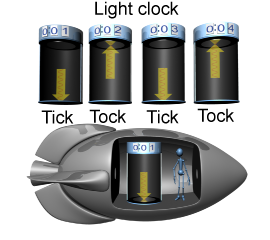|
Einstein thought deeply about what it meant for the speed of light to be constant to all observers. In the process, he came to surprising but inescapable conclusions that totally upended our notions of space and time. Prior to special relativity, time was a constant, flowing at the same rate for all observers. Einstein’s thought experiments about light led him to realize that time and even space were not constants after all. 
|
 Imagine a clock that counts trips of a beam of light going back and forth between two mirrors. This type of clock is similar to how an atomic clock works today. Einstein placed his imaginary clock on a moving spaceship. A person standing next to the clock sees the light go up and down, back and forth. In the moving reference frame of the spaceship, the time it takes the light to make one trip is twice the distance between the mirrors divided by the speed of light.
Imagine a clock that counts trips of a beam of light going back and forth between two mirrors. This type of clock is similar to how an atomic clock works today. Einstein placed his imaginary clock on a moving spaceship. A person standing next to the clock sees the light go up and down, back and forth. In the moving reference frame of the spaceship, the time it takes the light to make one trip is twice the distance between the mirrors divided by the speed of light. 
|
Next, consider a stationary observer outside the spaceship, watching from the ground. This stationary observer sees the light follow a zigzag path because the mirrors move with the spaceship. The zigzag path is longer than the simple up-and-down path seen by the observer inside the spaceship—yet the speed of light must be the same to all observers, regardless of their motion. Suppose it takes light one second to go between the mirrors. The speed of light must be the same for both people, yet the person on the ground sees the light travel a longer distance! 
|

|
The way to resolve this paradox is to realize that one second on the ground is not the same as one second on the spaceship. If one second of “ship time” is longer than one second of “ground time,” then the problem is resolved. The ground observer divides a longer distance by a longer “second” and measures 299,792,458 m/s. The shipboard observer finds the same value based on the ship’s time. The consequence of the speed of light being the same for all observers, Einstein’s concluded, is that time flows at different rates for observers in motion relative to each other. 
|
A major consequence of the speed of light being constant is that time slows down for objects in motion (including people). If you move fast enough, the change in the rate at which time passes can be enormous. For a spaceship traveling at 99.9% of the speed of light, 22 years would pass on Earth while a single year passes on the spaceship. The closer the spaceship’s speed is to the speed of light, the slower time flows for those aboard relative to those left behind on Earth. 
|
| |
|

